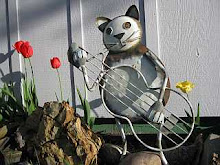Sunday I completed the second cutting of my hayfield. Saturday was another full day of cutting like Friday. I had a few hours left to finish the cut on Sunday. On Sunday I then also cut Donna's oats. She planted oats in the area where she used to pasture her horses. The oats wasn't ready to cut when I cut Donna's pasture in July. It was certainly ready to cut now as it was almost all dry. When I first start cutting I go in a reverse direction as the haybine needs to cut along the fence. So the tractor then drives in the stuff to be cut. Since the oats were so dry, and so tall, the tractor was warm from my prior work, and the temperature was 94 degrees, I was a little leery about doing the cut. I keep a fire extinguisher in the tractor's cab and I made sure I had it when cutting the oats. I kept an eye out in case a fire broke out. Fortunately none did. Once the initial cut was done the tractor then travels over the cut windrows as the haybine cuts the crop. Not as much danger as the tractor is not in the crop.
On Sunday I also "cut" the south pasture. I went over the pasture with the haybine a half foot or so off the ground. While the cattle are eating the grass there are still quite a number of tall grass they didn't eat, or clumps of tall grass around old cow pies. The cattle also favor parts of the pasture over other parts. The tall grass is either dry, or matured into stalks and not blades of grass. In the past sometimes a stalk of grass leans into a sprinkler head and then prevents the sprinkler's clapper from striking and turning the sprinkler head. So now I pull the tall grass near a sprinkler head. And one time recently when I bent over the adjust the pipe's connecting hook a stalk of grass went up one nostril of my nose until it hit deep inside my nostril. That hurt! Even though I am irrigating the pastures that doesn't really help the old tall grass. So I decided to lop off the top of the grasses. I figured it would take me 30 to 45 minutes. It took me over two hours.
Today I decided to "cut" the tall grass in the middle pasture. That took over three hours. In the north pasture I had a smaller area to "cut" and that only took an hour.
My irrigation line was at the west end in the south pasture so most of that pasture was "cut". The irrigation line across the middle and north pasture still has a day to go to reach the west end. So not all of the middle pasture was "cut". It would have nice to "cut" more of the middle pasture as there are a few areas the cattle had let the grass grow tall.
Once I reach the west end of the pastures I will head back to the east end before quitting irrigating for the year. So another eight days or so of moving irrigation lines twice a day. I can't wait for that to be over.
Hear is a photo of my main irrigation line that I put in the hayfield. The long lines are aluminum. The short lines are steel.
Earlier I had mentioned how the cattle like to flip the salt feeders over. Here is an example the morning I took the photo of the irrigation mainline pipes.
And you can see how the salt blocks get covered when the feeder is flipped over.
Monday, August 17, 2020
Subscribe to:
Post Comments (Atom)





No comments:
Post a Comment